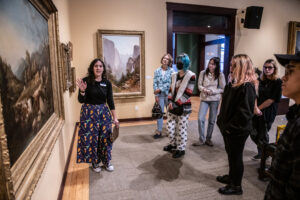

William H. Johnson (1901 – 1970) painted his Fighters for Freedom series in the mid-1940s as a tribute to African American activists, scientists, teachers, and performers as well as international heads of state working to bring peace to the world. He celebrated their accomplishments even as he acknowledged the realities of racism, violence, and oppression they faced and overcame.
In 2023, The Rockwell theme Heroes celebrates the courage of people moved by conviction, truth, and love to improve communities, society and our world. The twenty-eight paintings in this exhibition honor the legacy of individuals doing just this. But it’s not just the individuals depicted in the paintings that can be seen as the Hero. We owe a great deal to the artist William H. Johnson, a hero in his own right, for drawing upon his creative genius and capturing the stories of these influential figures in his art; by in doing so, he played an important role in preserving and sharing the significant stories of these “Fighters for Freedom.”
Some of his Johnson’s Fighters—Harriet Tubman, George Washington Carver, Marian Anderson, and Mahatma Gandhi—are familiar historical figures; others are less well-known individuals whose determination and sacrifice have been eclipsed over time. Johnson elevates their lives, offering historical insights and fresh perspectives. Through their stories he suggests that the pursuit of freedom is an ongoing, interconnected struggle, with moments of both triumph and tragedy, and he invites us to reflect on our own struggles for justice today. In Fighters for Freedom, Johnson reminds us that individual achievement and commitment to social justice are at the heart of the American story.

William H. Johnson at Work. U.S. National Archives and Records Administration.
Like the individuals he called Fighters for Freedom, Johnson understood struggle. He was born in Florence, South Carolina, in 1901, but left the Jim Crow South while still a teenager to go to New York City. There he worked at low-skilled jobs, saved money, and built a portfolio that would earn him admission to the National Academy of Design in 1921. By the time he completed the course of study five years later, he had won almost all the prizes offered by the distinguished institution. Then, like many aspiring artists of his generation, he left for Europe. In Paris and the south of France, he painted landscapes and light-struck villages that marked him as an up-and-coming modernist.
After three years abroad, Johnson returned to New York in 1930, where his paintings were acclaimed by national art critics. But he stayed less than a year. After visiting his family in South Carolina and making a quick stop in Washington, DC (where he renewed his friendship with Howard University professor Alain Locke and met poet Langston Hughes), he returned to Europe. In Denmark he married Holcha Krake, a weaver and ceramist he had met in Europe. For the next eight years, the couple lived in a small fishing village in Denmark and among the mountains and fjords of Norway, showing their work and traveling the continent.
The white world of Scandinavia offered Johnson a life relatively free of racial discrimination he had experienced as a Black man in the United States. But sales of his art were rare and, in late 1938, with World War II imminent, the couple returned to New York. Johnson abandoned the dazzling landscapes of his Scandinavian years to focus on the lives of African Americans in New York and the rural south. He painted sharecroppers, city hipsters, Black soldiers training for war, scenes inspired by Negro spirituals, and, his last series, Fighters for Freedom. In the late 1940s, devastated by his wife’s death from breast cancer and suffering from a degenerative brain illness, Johnson’s mental health began to deteriorate. In 1947, he was confined to Central Islip State Hospital in New York, where he remained without painting until his death in 1970.
 Join us for a limited time opportunity to explore the work of William H. Johnson and Robert Shetterly, two artists who, in different time periods, used real-life heroes as their inspiration. By engaging with a selection of artworks from these temporary exhibitions as well as from our permanent collection, students will be encouraged to think about being a real hero for their peers and communities. Funding for bussing and transportation is limited so please, consider booking early.
Join us for a limited time opportunity to explore the work of William H. Johnson and Robert Shetterly, two artists who, in different time periods, used real-life heroes as their inspiration. By engaging with a selection of artworks from these temporary exhibitions as well as from our permanent collection, students will be encouraged to think about being a real hero for their peers and communities. Funding for bussing and transportation is limited so please, consider booking early.
Learn more by contacting:
Ann Recotta, Education and Volunteer Programs Coordinator
recottaa@rockwellmuseum.org | 607-974-5505
Fighters for Freedom: William H. Johnson Picturing Justice is organized by the Smithsonian American Art Museum with generous support from Art Bridges, Faye and Robert Davidson, and the Jacob and Gwendolyn Lawrence Foundation.
 |
 |
No events found for 2024.
Be the first to know about activities at The Rockwell by signing up for our e-newsletter. Choose the topics that interest you: exhibitions and collections news, live music events, lectures, family and youth events, education news, volunteer opportunities, and new offerings from The Museum Store.
Sign up for our e-newsletter